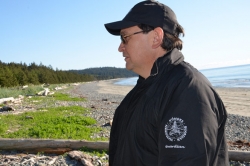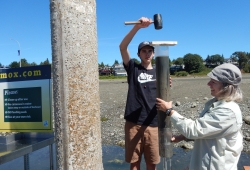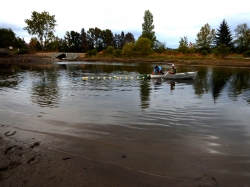K'omoks Estuary:
In June 2015, the K’omoks Guardian Watchmen played a pivotal role in an initiative aimed at improving the health of the K'omoks Estuary, a place senior Watchman Cory Frank describes this way: “I feel the estuary is the most important area in our territory. An estuary is a living, breathing entity, and everything starts from it. For us, the K’omoks Estuary has been a living part of our Nation since time immemorial. That’s why it’s so important to take care of it this way.”
Lagoon Breach Project:
After four years of study and planning and with funding from the Recreational Fisheries Conservation Partnerships Program, Fish and Wildlife Compensation Program, North American Partnership for Environmental Community Action, and the City of Courtenay, in the summer of 2015 a two-week project was coordinated by environmental stewardship group Project Watershed to breach the Courtenay Airpark Lagoon and reconnect it with the Courtenay River.
The breach is in the form of a culvert which directs river flows through the lagoon area, flushing and re-oxygenating the area with cooler river water and helping transform the lagoon to something more like its historical state. Project Watershed and K’omoks First Nation hope the project will significantly improve fish habitat in the lagoon and the K’omoks Estuary, and deal with factors limiting productivity in the area.
Partnerships:
The K'ómoks Guardians worked with Project Watershed to do the required environmental monitoring for the project. “Guardian Antonio Billie spent two weeks on the project, monitoring everything from the set-up of the silt fence, turbidity tests, debris removal, and seining in the lagoon for any and all species of fish—perch and stickleback are the two most common species,” says Cory. “The Guardian also monitored any environmental impacts directly due to the work being done, and checked the silt fence on a daily basis, as well as the work on the replacement of the culvert and all the surrounding earth and vegetation.”
The Rewards of Environmental Partnerships:
The project was significant environmentally—within weeks, new aquatic growth was visible as a result of the work—but also in terms of K’omoks First Nations partnerships in the region. “It was a really great project in terms of getting our feet wet in the environmental monitoring field,” observes Cory. “But it also has contributed to building strong relationships with local environmental stewardship groups in our territory with a common interest in protecting it. For the K’omoks Guardians,” he concludes, “it is a real honour to be active stewards of the estuary and partnering on a project like this is a big part of that.”



